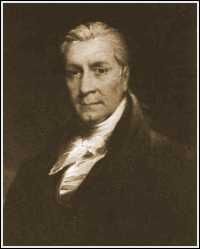FRtR > Biographies > Thomas Fitzsimons
A Biography of Thomas Fitzsimons 1741-1811
*** Quote ***
 Fitzsimons (FitzSimons; Fitzsimmons) was born in Ireland in 1741. Coming to America about 1760, he pursued a mercantile career in Philadelphia. The next year, he married Catherine Meade, the daughter of a prominent local merchant, Robert Meade, and not long afterward went into business with one of his brothers-in-law. The firm of George Meade and Company soon became one of the leading commercial houses in the city and specialized in the West India trade.
Fitzsimons (FitzSimons; Fitzsimmons) was born in Ireland in 1741. Coming to America about 1760, he pursued a mercantile career in Philadelphia. The next year, he married Catherine Meade, the daughter of a prominent local merchant, Robert Meade, and not long afterward went into business with one of his brothers-in-law. The firm of George Meade and Company soon became one of the leading commercial houses in the city and specialized in the West India trade.
When the Revolution erupted, Fitzsimons enthusiastically endorsed the Whig position. During the war, he commanded a company of militia (1776-77). He also sat on the Philadelphia committee of correspondence, council of safety, and navy board. His firm provided supplies and "fire" ships to the military forces and, toward the end of the war, donated £: 5,000 to the Continental Army.
In 1782-83 Fitzsimons entered politics as a delegate to the Continental Congress. In the latter year, he became a member of the Pennsylvania council of censors and served as a legislator (1786-89). His attendance at the Constitutional Convention was regular, but he did not make any outstanding contributions to the proceedings. He was, however, a strong nationalist.
After the convention, Fitzsimons continued to demonstrate his nationalistic proclivities as a three-term U.S. representative (1789-95). He allied himself closely with the program of Hamilton and the emerging Federalist Party. Once again demonstrating his commercial orientation, he advocated a protective tariff and retirement of the national debt.
Fitzsimons spent most of the remainder of his life in private business, though he retained an interest in public affairs. His views remained essentially Federalist. During the maritime difficulties in the late 1790s, he urged retaliation against British and French interference with American shipping. In the first decade of the 19th century, he vigorously opposed Jefferson's embargo of
1807-9. In 1810, again clashing with the Jeffersonians, he championed the recharter of the First United States Bank.
But Fitzsimons's prominence stemmed from his business leadership. In 1781 he had been one of the founders of the Bank of North America. He also helped organize and held a directorship in the Insurance Company of North America and several times acted as president of the Philadelphia
Chamber of Commerce. His financial affairs, like those somewhat earlier of his associate and fellow-signer Robert Morris, took a disastrous turn in 1805. He later regained some of his
affluence, but his reputation suffered.
Despite these troubles, Fitzsimons never ceased his philanthropy. He was an outstanding supporter of Philadelphia's St. Augustine's Roman Catholic Church. He also strived to improve public education in the commonwealth and served as trustee of the University of Pennsylvania.
Fitzsimons died at Philadelphia in 1811 after seven decades of life. His tomb is there in the graveyard at St. Mary's Roman Catholic Church, which is in present Independence National
Historical Park.
 Fitzsimons (FitzSimons; Fitzsimmons) was born in Ireland in 1741. Coming to America about 1760, he pursued a mercantile career in Philadelphia. The next year, he married Catherine Meade, the daughter of a prominent local merchant, Robert Meade, and not long afterward went into business with one of his brothers-in-law. The firm of George Meade and Company soon became one of the leading commercial houses in the city and specialized in the West India trade.
Fitzsimons (FitzSimons; Fitzsimmons) was born in Ireland in 1741. Coming to America about 1760, he pursued a mercantile career in Philadelphia. The next year, he married Catherine Meade, the daughter of a prominent local merchant, Robert Meade, and not long afterward went into business with one of his brothers-in-law. The firm of George Meade and Company soon became one of the leading commercial houses in the city and specialized in the West India trade.